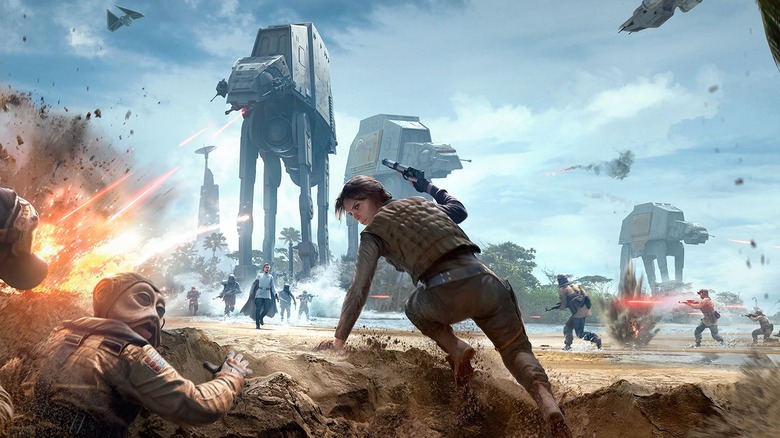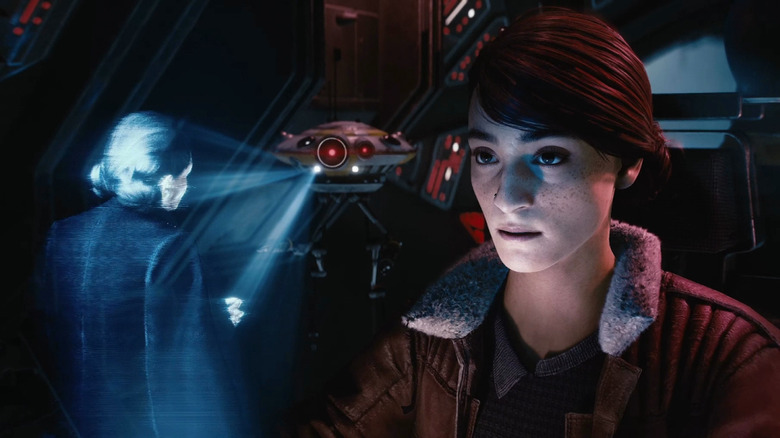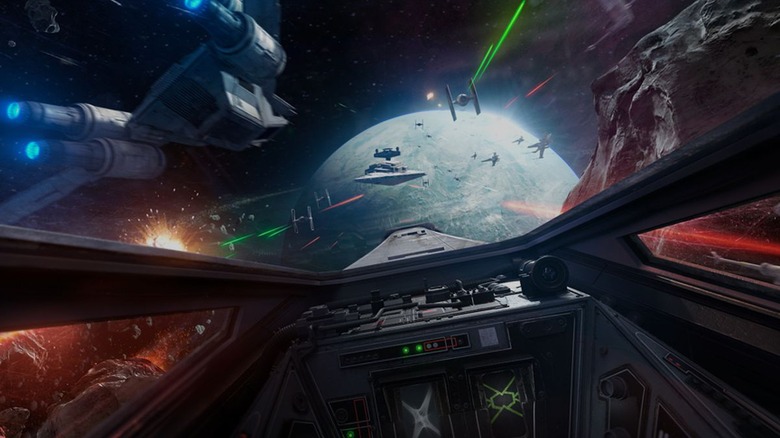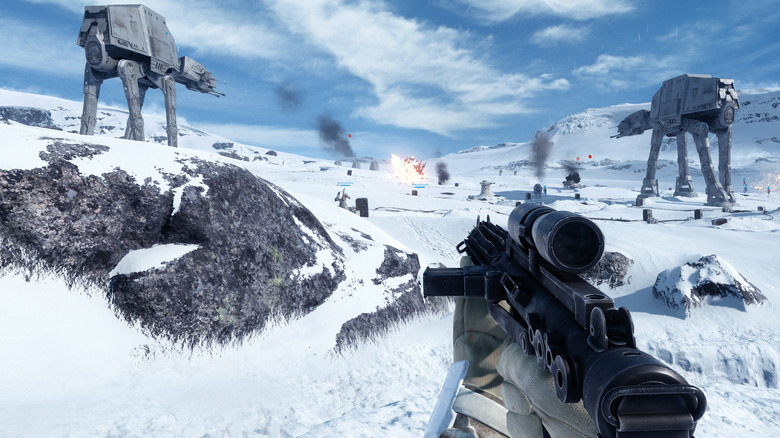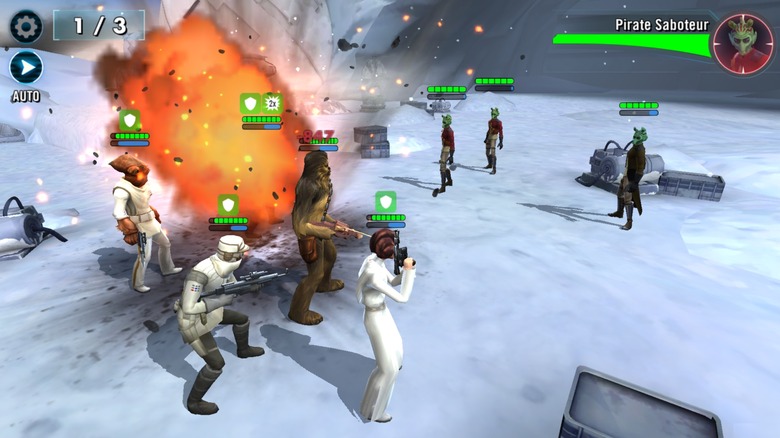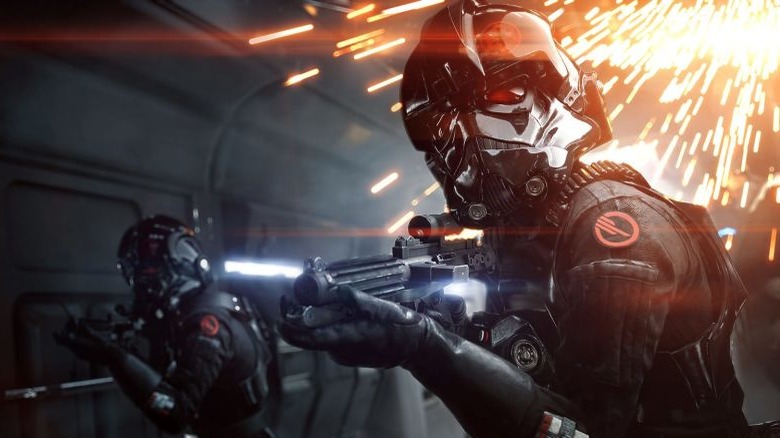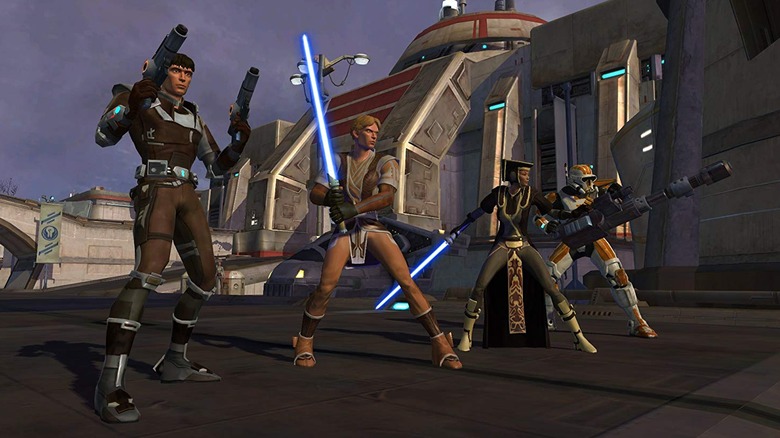Every EA Star Wars Game Ranked
A long time ago in a galaxy far, far away, LucasArts was the company responsible for publishing the video games set in the Star Wars universe. Much like the Jedi, however, their time eventually came to an end. In 2012, the Walt Disney Company bought Lucasfilm, and they closed LucasArts the following year. Disney then signed a deal with Electronic Arts, who became the exclusive distributor for future Star Wars games, which were set to be developed by studios DICE, Visceral, and BioWare. This was exciting at the time, particularly because BioWare and EA were responsible for Star Wars: The Old Republic, an MMO set in the franchise's distant past (but more on The Old Republic, later).
What followed this deal with the House of Mouse, however, has been the subject of a great disturbance in the fan community. Over the years, EA's Star Wars games have seen varying degrees of success in the place where it really counts: the hearts of the players. Let's take a look at the four Star Wars titles that EA has released so far, as well as some of those games' related content, and see how they stack up with one another, from worst to best (or from "I have a bad feeling about this" to "Goooood").
Star Wars: Battlefront 2 -- Resurrection
Listen, DLC expansions are usually a cool idea, especially when they elaborate on the game's story in new ways or tell a fun side story that enriches the experience of the core game. However, no one should ever have to purchase a DLC for the express purpose of seeing how the original game's story is supposed to end. It was annoying when Asura's Wrath did it, and it's possibly even more annoying here.
Though Star Wars: Battlefront 2 attempted to overcome one of the first installment's biggest criticisms by adding a decent single-player story mode, the execution was a bit fumbled. The main campaign ended on a pretty major cliffhanger that moved the story 30 years into Battlefront 2's future, coinciding with the events of The Last Jedi. In the game's dramatic ending, (SPOILERS) Kylo Ren tortures Battlefront 2 protagonist Iden Versio's husband for information on the whereabouts of Luke Skywalker.
The Resurrection DLC was released alongside The Last Jedi, but it barely ties into the story of that film or the preceding installment, The Force Awakens, aside from the ability to play as Finn and Captain Phasma from the new trilogy. Not only that, but as PC World points out in their review of Resurrection, the DLC's storyline consists of three brief missions and then "it fizzles out just like the original story ... Resurrection ends on another pseudo-cliffhanger." This ultimately begs the question: what was the point?
Star Wars: Battlefront -- Rogue One X-Wing VR Mission
Released as a DLC for EA's first Battlefront, Rogue One X-Wing VR Mission was a flight combat simulator set in the time-frame of 2016's Episode IV prequel, Rogue One: A Star Wars Story. It's an exceptionally immersive experience, with Trusted Review's Ced Yuen calling it "the most exhilarating thing I've experienced in VR, as well as a childhood dream come true." Honestly, the only reason X-Wing VR ranks lower than some of EA's other Star Wars offerings is, as Yuen goes on to mention, the single playable level runs for less than half an hour, which leads to it feeling more like a proof-of-concept than a full experience.
Still, X-Wing VR is definitely worth checking out for Star Wars fans. Despite its short runtime, Destructoid notes, "The mission has replayability with optional objectives ('take down 70-some TIE fighters,' 'keep your whole squad alive,' that sort of thing)." In other words, there's just enough content there to keep the experience fresh for at least a couple of playthroughs. Also, it's a free download for folks who own 2015's Star Wars: Battlefront on PlayStation 4, so there's no real reason not to give this one a shot if you have PSVR. Just make sure you don't get cocky when you take down your first TIE fighter.
Star Wars: Battlefront
This may need to be clarified right up front, so here it is: Battlefront isn't exactly a bad game, just a fairly underwhelming one. The title, which brings to mind two other well-loved shooter games from the early 2000s from LucasArts and Pandemic Studios, immediately conjured unparalleled levels of excitement when it was first announced. While 2015's Star Wars: Battlefront launched to huge sales numbers, gamers had numerous problems with the overall experience right off the bat, including issues with players being able to even get into matches.
In contrast with many other popular shooters, it was noted that the game did not feature quite the same depth of combat as some other shooter games. This concern was addressed by the CFO of EA, Blake Jorgensen, who said that EA "had designed it to be a much more accessible product to a wide age group ... for the hardcore, it may not have the depth that they wanted in the game."
The simplified gameplay was already a bit of a minus for folks going into this new iteration of Battlefront, but what also really bummed people out was the complete lack of a story mode for the game. This sentiment was echoed by actor John Boyega, who portrays Finn in the Star Wars films; though Boyega seemed to enjoy Battlefront overall, he tweeted that the game "leaves you wanting to engage within a narrative."
Star Wars: Galaxy of Heroes
While it may seem crazy to rank a mobile game over a major release like Battlefront, there's a good reason for this: Galaxy of Heroes is honestly just more fun to play. The characters are collected as cards, similar to those in the Injustice: Gods Among Us mobile game, which may make fans of the wider Star Wars universe more likely to devote extra hours of play to finding and unlocking more of their favorites. There are actually some fairly obscure characters in this game, like Dengar the Bounty Hunter. It's pretty easy to get addicted to Galaxy of Heroes, just to see who else is unlockable.
While Galaxy of Heroes is as plotless as Battlefront, and regular mobile game microtransactions are still present, the turn-based battles are still fun without making you feel like you have to pay to win. As Kotaku's overview of Galaxy of Heroes mentions, "The rewards are amazing — tons of in-game money, lots of experience booster items, power-enhancing ability shards." These rewards in turn encourage players to customize and level up their collected characters.
Galaxy of Heroes also receives fairly frequent content updates, with Guilds and Raid Bosses being added after the game's launch. These offered incentives like new unlockable characters for successful Raids and introduced more of a social element to the game. All in all, despite being much smaller in scale than Battlefront, Star Wars: Galaxy of Heroes does more to enhance replay value.
Star Wars: Battlefront 2
Star Wars: Battlefront 2 is a stronger, more well-rounded game than its predecessor, but many of its good qualities still come with a downside. For example, an intriguing single-player campaign was added for Battlefront 2, which raises it a few notches in this ranking. On the other hand, as mentioned before, the story mode requires a DLC to see the "true" ending, which leaves that part of the game feeling somewhat unfinished. Another example is 2019's addition of an exciting new gameplay mode called Capital Supremacy. In Kotaku's rundown of Capital Supremacy, they noted that it featured "teams of 20 vs 20 with an additional 12 units on both sides that are controlled by AI" and that it was "fun to mess around in." However, Kotaku also pointed out that many of the same matchmaking and connectivity issues experienced with the first Battlefront were still present here. Battlefront 2 is a fun game, but it's one with a lot of give-and-take.
Battlefront 2 also drew controversy as early as its beta-testing stage, due to its many microtransactions. The game's paid loot system received harsh criticism, with Motherboard referring to the game as "a bleak, Candy Crush version of a Star Wars game." EA eventually dropped microtransactions from Battlefront 2 for everything other than cosmetic changes. EA's Fallen Order will likewise be microtransaction-free. If nothing else, Battlefront 2 may deserve some credit for convincing EA to learn from some of its mistakes with the Star Wars license.
Star Wars: The Old Republic
Star Wars: The Old Republic is a far more solid experience than many people give it credit for. The game's lore embraces the broader Star Wars canon in ways that the mostly "here's your blaster; shoot everything" mentality of the Battlefront series seems uninterested in. Its combat system has enough depth to differentiate it from similar MMOs, and it has a great voice cast.
The truth is, many of The Old Republic's problems stemmed from differences in priorities during development: EA wanted this MMO to be a World of Warcraft-killer, while BioWare hoped to make a story-driven RPG in the vein of their Knights of the Old Republic series. As Polygon points out, the end result was a game that "couldn't decide whether it was more important to be an MMO ... or a narrative-heavy RPG where getting to the next cutscene was your main goal ... neither aspect of the game was satisfying."
The Old Republic still receives new content every now and then: 2015's update, Knights of the Fallen Empire, received critical praise, with Kotaku calling it "vastly more user-friendly," compared to how it launched. Meanwhile, 2019's fall release of Onslaught is SWTOR's first expansion in a few years. While the game isn't quite as populated as it once was, The Old Republic still has a devoted fanbase that proves its worth to the overall Star Wars brand and makes one hopeful for a future EA game that can recapture that magic.

